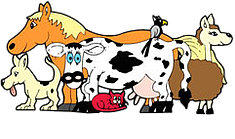Megaoesophagus or Oesophageal Dilation
 What is megaoesophagus?
What is megaoesophagus?
This condition results from dilation or paralysis of the oesophagus or tube which connects the mouth with the stomach. There is also an inability of the oesophagus to contract and push the swallowed food into the stomach. In consequence the food accumulates in the gullet and results in vomiting or more correctly, regurgitation of the meal, a variable time after the dog has eaten. Fluids will usually run down into the stomach but in some cases these too can be regurgitated some time after drinking.
Are some breeds more prone?
The condition is not uncommon in dogs and appears to be congenital in some. There appears to be a familial predisposition in Wire-haired Fox Terriers and Miniature Schnauzer as well as German Shepherd dogs, Great Danes and Irish Setters. Some forms of the condition appear to be truly congenital (present from birth) and these will be evident shortly after weaning. Due to its variety of causes megaoesophagus can, however, occur in dogs of any age.
What are the signs?
Frequent regurgitation after eating, together with a failure to thrive, are the main signs. Because of the frequent regurgitation the animal often has a chronic pneumonia. This will result in coughing and sometimes a mucopurulent nasal discharge. Feeding difficulties may be observed.
Causes
The congenital form may or may not be hereditary. Other causes can include central nervous system disorders as well as neuromuscular diseases such as myasthenia gravis and systemic lupus erythematosis.
Inflammation of the oesophagus from a variety of causes can also result in this unfortunate condition.
Damage following an oesophageal obstruction, for example a bone in the throat, can result in megaoesophagus due to damage to the oesophagus.
Unfortunately, in approximately half of the cases seen, a cause is not able to be determined and this is called idiopathic megaoesophagus.
Diagnosis
The condition can often be suspected on the symptoms particularly if it is noted that there is improvement if the dog is fed with the head in a raised position.
"The condition can often be suspected on the symptoms particularly if it is noted that there is improvement if the dog is fed with the head in a raised position."
Once a tentative diagnosis has been made it is usual to undertake fairly exhaustive laboratory and diagnostic procedures including radiography, endoscopy, barium swallows etc.
Treatment
This involves careful management. Your veterinarian will give you instructions regarding feeding in an upright position, either with the food bowl raised on a stool or on steps etc. Sometimes antibiotics and other drugs are prescribed on a long term basis in order to minimise complications such as pneumonia. Repeat radiography and other tests are frequently necessary.
Will treatment cure my dog?
The condition is frequently incurable although careful management will allow the dog to lead a relatively normal life. However this can be expensive both in terms of time and money and we are more than happy to discuss all these aspects with you.
Megaoesophagus in puppies that has been present from birth sometimes resolves as the puppy reaches adulthood. Unfortunately this cannot be guaranteed.
© Copyright 2025 LifeLearn Inc. Used and/or modified with permission under license. This content written by LifeLearn Animal Health (LifeLearn Inc.) is licensed to this practice for the personal use of our clients. Any copying, printing or further distribution is prohibited without the express written consent of LifeLearn. This content does not contain all available information for any referenced medications and has not been reviewed by the FDA Center for Veterinary Medicine, or Health Canada Veterinary Drugs Directorate. This content may help answer commonly asked questions, but is not a substitute for medical advice, or a proper consultation and/or clinical examination of your pet by a veterinarian. Please contact your veterinarian if you have any questions or concerns about your pet’s health. Created on Jun 16, 2015.

